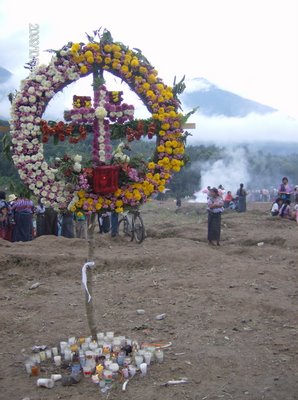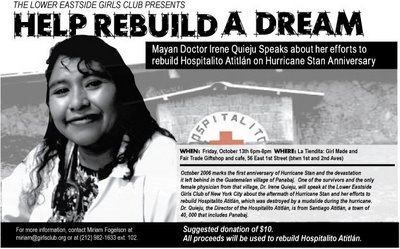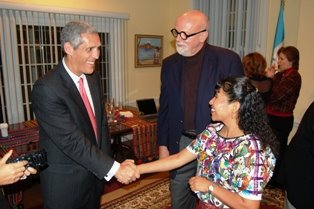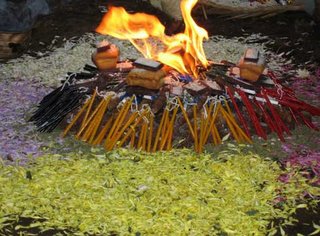
Day of the dead is celebrated across norther Latin America after our Halloween. People take time to remember those who are no long with us, and there are a whole host of other activities that vary region to region. In Atitlán it is quite a big deal, as well.
I'd like to ask our readers to take a moment to remember those who were lost that fateful night in October today. Below is a beautiful piece by Kathy Searle about the ceremony that took place on the one year anniversary of the mudslide.
(“Awakening with hope in memory of the departed”)
Caminata by candlelight: Santiago Atitlán mourns its dead
Thursday, October 5, 2006 –
Commemoration ceremonies on the first anniversary of the tragedy wrought by Tropical Storm Stan one year ago, when torrential rains and mudslides caused the death of over two hundred people, including whole families, and left over four thousand homeless in this town of about 36 thousand.
Four a.m., by the soccer field, and no moon. It felt cold. A few handfuls of people huddled together in doorways, or perched on the wall of the sports ground. We were the early birds, apparently, at the designated starting point for the caminata, or procession.
Dr. Juan Chumil drove by and pulled over, on his way from the adjacent town of San Lucas Tolimán, where he lives. Juan is the Director of the Public Health Center, and it is thanks in large part to his effective leadership and coordination within the health sector that Santiago experienced none of the outbreaks of serious epidemics (such as cholera and typhoid) which so often occur in the aftermath of a natural disaster. An experienced networker and versatile, hands-on leader, and also a strong supporter of the Hospitalito, Dr. Chumil lives up to his name, which mean “star” in Kaq’chikel.
“Aren’t you up awfully early, Doctor?” I asked. “No. I could not miss this caminata,” he replied. “I have to be here, out of respect for what happened here, and for the dead.”
Next to arrive on the scene was Francisco Coché, President of the Cantón Panabaj Association and newly appointed by the Town Council as Reconstruction Coordinator. Francisco carried a large bouquet of white flowers and a large church taper, as did many others who came with him. His quiet self-assurance commanded attention, and the crowd formed two lines on either side of the road upon his soft-spoken request in Tz’utijil and Spanish. Hand-held banners were unfurled. Placards appeared with the names and photos of schoolchildren who lost their lives in Panabaj. A municipal truck sported more signs, with the names and ages of other victims. The preponderance of small children and the elderly was striking.
Suddenly things picked up their pace. The Bomberos Voluntarios, Santiago’s volunteer firefighters, decorated for their valiant performance during the rescue operations, when they saved many lives at great risk to their own, arrived in two ambulances and took up their positions at the head and the rear of the of the procession, and marchers lit their candles. The caminata began.
As we moved forward, the ambulances sounded their sirens in short bursts, low and eerily mournful in the pre-dawn gloom. Sleepy neighbors appeared at their doorsteps, peered down from balconies, and lined the street as the procession passed. The early buses heading out of town pulled to the side of the road respectfully to let us by. The damp wind off the Lake penetrated our wraps, but it felt right to be walking together.
As the caminata approached the last corner before the town square, it was joined by the Mayor and Council members as well as other marchers. These included community members (adults and children, indigenous and ladinos alike), members of the local expat population, representatives of national and international NGOs working in the area: anyone who wanted to express their solidarity and share the grief of the many bereaved families of Santiago. By the time the line of walkers left the park, it was several hundred strong.
Climbing up the hill en route to the cemetery, I stopped and looked back. The caminata made an impressive sight, with its banners and candles bobbing along in the darkness.
Dawn was breaking by time we reached the cemetery gates, where we paused for speeches in Tz’utujil and Spanish by local and state dignitaries. The national press was present, and full coverage would appear in next day’s newspapers. The tragedy in Panabaj has come to epitomize the suffering of the entire country in the wake of Stan.
Also present was the team of forensic anthropologists slated to begin exhumations in November: a grim reminder that the 76 bodies buried in the cemetery were just those which were recovered immediately following the mudslides. It is estimated that some 132 cadavers remain buried in Panabaj in the area surrounding the original Hospitalito facilities, waiting to be excavated and identified by these experts. There have been many delays in getting official authorization to initiate the exhumations, but the affected families badly need to recover the remains of the victims and bury them if they are ever to get closure on their bereavement. The Hospitalito Atitlán has agreed to loan Module III, the new kitchen-laundry-storeroom facility within a day or two of being occupied when the mudslide occurred, to serve as a temporary morgue for the forensic team.
Last year at this time, the mud and rain had made it impossible to do more then bury the victims in adjacent graves near the cemetery’s entrance. Mourners placed flowers and candles on the crosses marking their families and friends, and the sound of sobbing lamentations filled the air.
After some time, the procession regrouped and continued its trek along the back roads to the site of the mudslide in Panabaj, to honor the victims who remain under ground there. By this point, full daylight was upon us, and the Mayor reiterated his speeches from the back of the municipal truck which served as an impromptu stage, inviting his listeners to attend the various events scheduled throughout the day as part of the commemoration activities.
The caminata ended as individuals dispersed to leave flowers and candles at the various improvised altars which have sprung up around the mudflats which now cover the floodplain on which the bustling neighborhood of Panabaj was once located, its humble homes interspersed among numerous coffee groves and cornfields. Now, all was cold, dusty and barren.







